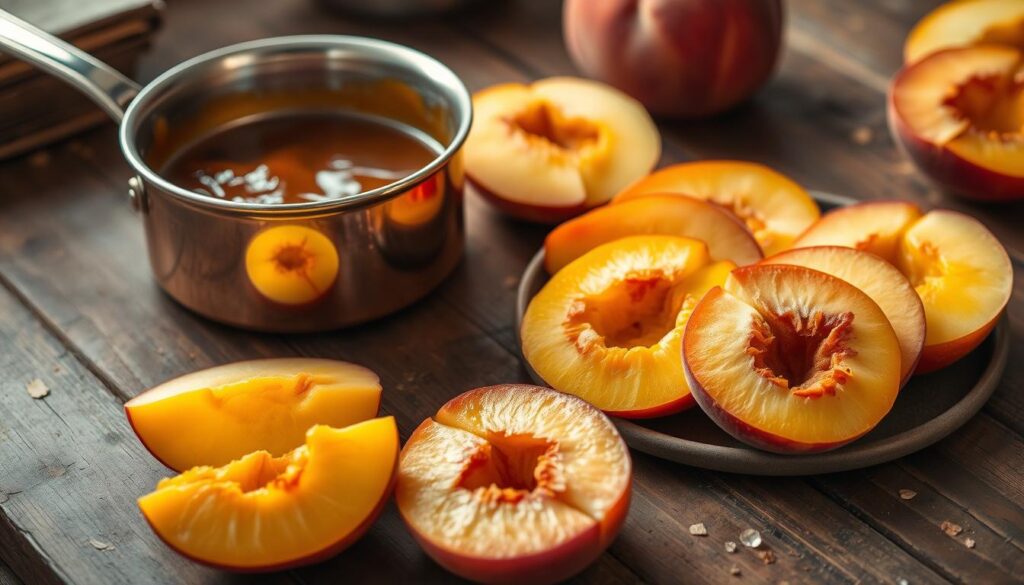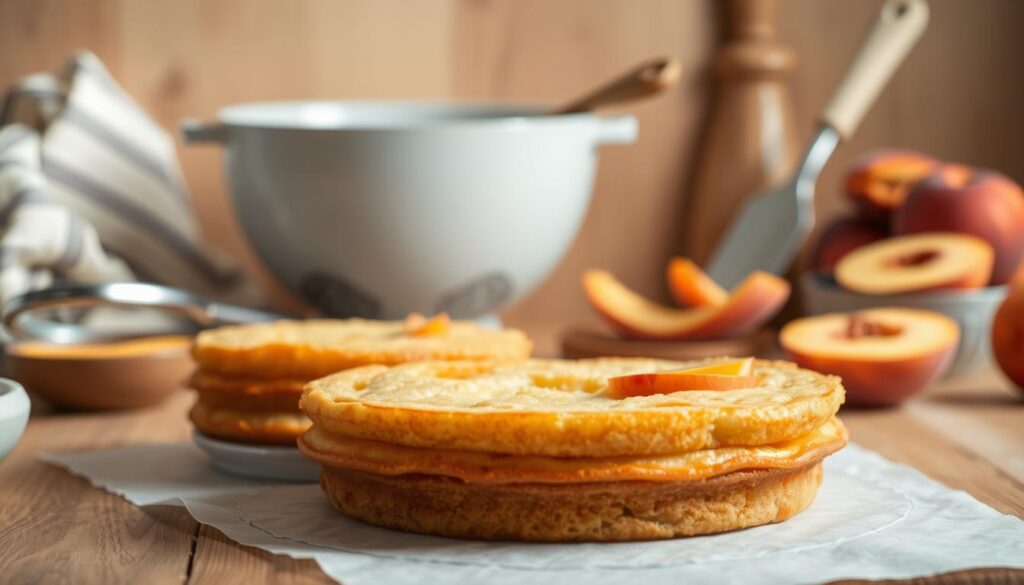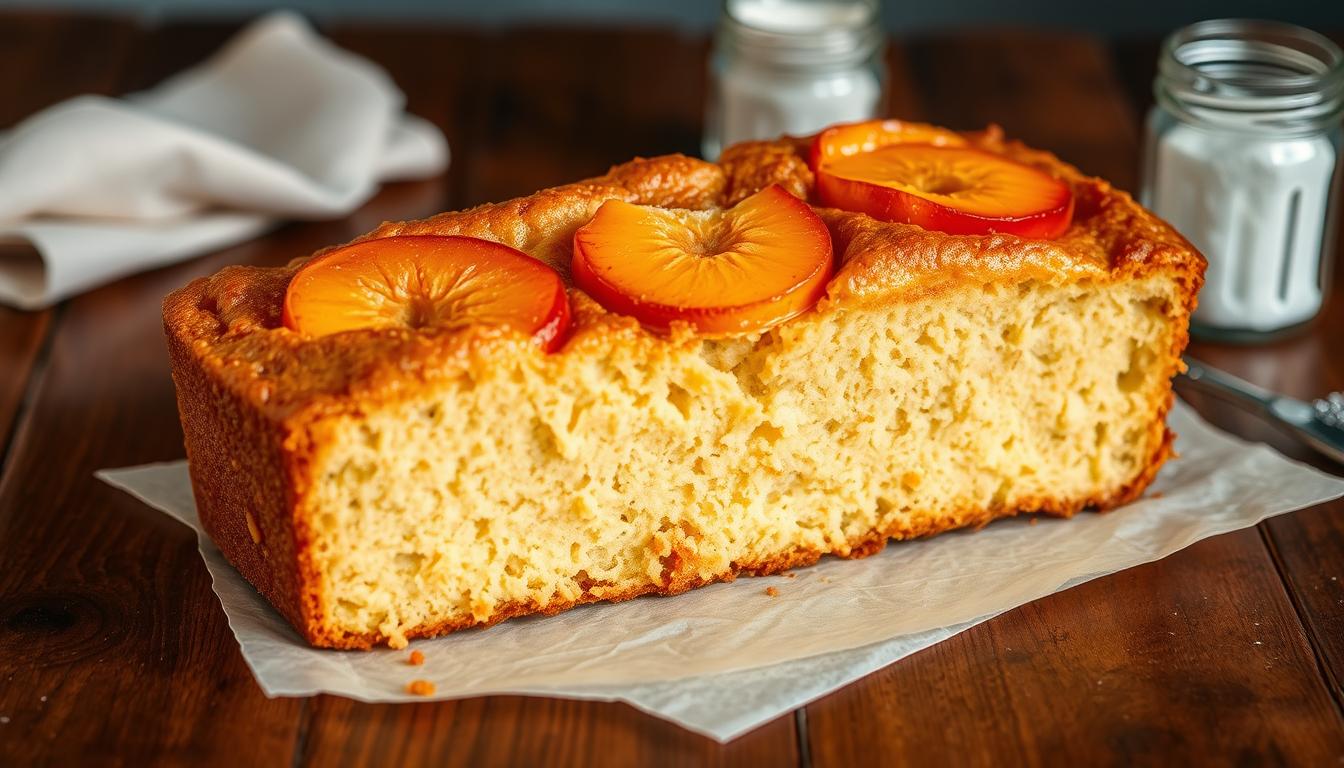Imagine a dessert that combines the warmth of a peach cobbler with the richness of a pound cake. This irresistible treat is a game-changer for any occasion. Loaded with juicy peaches and a delightful biscuit crumble topping, it’s a perfect blend of flavors and textures.
Thank you for reading this post, don't forget to subscribe!In this article, we’ll guide you through a detailed, step-by-step recipe. From precise ingredient measurements to expert techniques, we’ve got you covered. Whether you’re using fresh or canned peaches, this peach cobbler pound cake is sure to impress.
Discover tips on achieving the perfect texture and testing for doneness. With this recipe, you’ll create a dessert that’s both memorable and mouthwatering. Let’s dive in and make something extraordinary!
Key Takeaways
- Combines the best of peach cobbler and pound cake for a unique dessert.
- Loaded with juicy peaches and a crunchy biscuit topping.
- Step-by-step guide with precise measurements and techniques.
- Works beautifully with both fresh and canned peaches.
- Tips for testing doneness and achieving the perfect texture.
Introduction to This Delicious Recipe
Discover a dessert that brings together the warmth of a cobbler and the richness of a pound cake. This irresistible treat is a must-try for any dessert lover, offering a unique flavor profile that combines the best of both worlds.
What Makes This Cake Irresistible
This cake stands out with its buttery texture, vibrant peach layers, and a delightful crumble topping. The caramelized peaches add a depth of flavor that elevates this dessert to new heights. Each bite is a perfect balance of flavors and textures, making it a standout choice for any occasion.
Overview of the Recipe Process
Crafting this masterpiece begins with gathering high-quality ingredients and tools, such as a bundt pan. The process involves layering the cake batter with fresh peaches and the crumble topping, followed by baking to perfection. This article will guide you through every step, from preparation to the finishing touches, ensuring a memorable dessert experience.
Gathering Quality Ingredients for Your Cake
Creating a standout dessert begins with selecting the finest ingredients. For this recipe, you’ll need essential components like unsalted butter, granulated sugar, and fresh peaches. These elements form the foundation of a moist and flavorful treat.
Key Ingredients: Butter, Sugar, and Fresh Peaches
The recipe calls for 1 cup of unsalted butter, ensuring a rich, creamy base. You’ll also need 1 ¾ cups of granulated sugar and ¼ cup of brown sugar for depth. Fresh peaches are a star ingredient—use 2 cups of sliced peaches for a vibrant, juicy texture.
Ingredient Substitutions and Tips
- For buttermilk, mix 1 cup of milk with 1 tablespoon of white vinegar or lemon juice.
- Replace up to half of the granulated sugar with brown sugar for added depth.
- Use 1 ½ cups of all-purpose flour with 2 ¼ teaspoons of baking powder as a substitute for cake flour.
Quality ingredients are crucial for achieving the perfect texture and flavor. Using real butter and fresh peaches ensures authenticity, while allowing substitutions offers flexibility. This balance makes the recipe adaptable yet consistent in quality.
Crafting the Perfect Biscuit Crumble and Streusel
The biscuit crumble and streusel topping is a crucial element that elevates your dessert to new heights. It adds a delightful crunch and flavor contrast to the moist fresh peach layers. To achieve this, you’ll need to focus on both the ingredients and the technique.
Mixing Spices: Cinnamon, Nutmeg, and Cardamom
The spice blend is where the magic begins. Combine 1 ½ teaspoons of cinnamon, ¼ teaspoon of nutmeg, and a pinch of cardamom. This mixture adds warmth and depth to the crumble, complementing the sweetness of the fresh peaches. The cardamom, in particular, provides a unique aromatic flavor that enhances the overall taste experience.
Techniques for Achieving a Crumbly Texture
To get that perfect crumble, start with cold butter. Use ½ cup of unsalted butter, cut into small cubes, and mix it with 1 ¼ cups of flour, ½ cup of brown sugar, and ¼ cup of granulated sugar. The key is to keep the butter in small pieces to ensure a light, crumbly texture. Use your fingers or a pastry blender to work the butter into the dry ingredients until it resembles coarse crumbs.
Avoid overmixing, as it can make the streusel dense. Instead, stop once the mixture is just combined. This technique ensures a delicate crunch that adds texture to your dessert without overpowering the other flavors.
Pro Tip: For the best results, chill the crumble mixture in the refrigerator for about 10 minutes before baking. This step helps the butter firm up, leading to a flakier texture when baked.
When it’s time to bake, spread the crumble evenly in the pan. This ensures uniform baking and prevents some areas from burning while others remain undercooked. Bake at 350°F for 12-15 minutes, stirring every 5 minutes, until golden brown.
You can prepare the crumble a day in advance to save time. Simply store it in an airtight container at room temperature. This not only saves time but also allows the flavors to meld together, enhancing the overall taste.
Whether you’re using fresh or canned peaches, the crumble remains a consistent element. For canned peaches, pat them dry before layering to ensure the crumble adheres properly. This small step makes a big difference in the final texture and appearance of your dessert.
By following these steps, you’ll create a crumble that’s both delicious and visually appealing. It’s the perfect finishing touch for your dessert, adding that extra layer of flavor and texture that will make it truly unforgettable.
Preparing Fresh Peaches and Caramel Base
The art of preparing fresh peaches and crafting a caramel base is a crucial step in creating an irresistible dessert. This process not only enhances the flavor but also ensures a visually appealing result.
Peach Preparation: Peeling, Slicing, and Dicing
Begin by peeling the peaches using either a vegetable peeler or the blanching method. Blanching involves briefly submerging the peaches in boiling water to loosen the skin, then transferring them to an ice bath for easy peeling. Once peeled, slice the peaches into uniform pieces for the topping, ensuring even caramelization during baking. Dice a second peach for incorporation into the batter, adding natural sweetness and texture to the dessert.
Creating the Caramel Base
To make the caramel, cook granulated sugar and water over medium heat, stirring occasionally. Once the mixture turns a light amber, remove it from the heat immediately to prevent burning. This caramel base allows the peaches to infuse their flavor into the dessert during baking, creating a rich and aromatic profile. The brief cooking time ensures the caramel remains smooth and sweet without overpowering the other ingredients.

Creating the Ultimate Cake Batter
The cake batter must be perfect to craft a truly exceptional dessert. This section will guide you through the precise steps to create a smooth, airy batter that ensures a tender crumb and a moist texture.
Steps for Creaming Butter and Sugar
Begin by creaming 1 ½ cups of room-temperature unsalted butter with 2 ½ cups of granulated sugar. This process typically takes about 3-4 minutes, until the mixture becomes light and fluffy. Pro Tip: Stop mixing once the butter and sugar are just combined to avoid overmixing, which can lead to a dense texture.
Incorporating Eggs and Buttermilk for Fluffiness
Add 6 large eggs one at a time, allowing each egg to fully incorporate before adding the next. This method ensures a stable emulsion, which is crucial for the cake’s structure. Gradually mix in 1 cup of sour cream, enhancing the batter’s moisture and fluffiness. The dry ingredients should be added gradually to prevent overmixing, ensuring a smooth and even batter.
By following these methodical steps, you’ll achieve a batter that’s both smooth and airy, setting the foundation for a truly unforgettable dessert experience.
Assembling the Cake with Precision
Now that we’ve prepared all the components, it’s time to bring everything together. Assembling the cake requires careful layering to ensure each bite is packed with flavor and texture.
Layering the Batter, Peaches, and Crumble
Start by pouring a thin layer of the cake batter into the prepared bundt pan, spreading it evenly. Next, add a layer of diced peaches, gently folding them into the batter to avoid breaking apart. Sprinkle a portion of the biscuit crumble over the peaches for a burst of flavor and texture. Repeat this process, alternating between layers of batter, peaches, and crumble until all ingredients are used, ending with a layer of crumble on top.
To ensure even baking and prevent air bubbles, lightly tap the pan on the counter. This step ensures a uniform distribution of ingredients throughout the cake. Precision in layering is key to achieving the perfect balance of flavors in every slice.
| Layer | Components | Purpose |
|---|---|---|
| Batter | Cake mixture | Provides structure and moisture |
| Peaches | Diced peaches | Adds natural sweetness and texture |
| Crumble | Biscuit crumble mixture | Enhances flavor and texture contrast |

Pro Tip: For the best results, ensure each layer is evenly spread and that the crumble is distributed uniformly. This attention to detail will make your dessert truly unforgettable.
Baking and Perfecting Your Cake
Now that your cake is assembled, it’s time to bring it to life in the oven. Proper baking and cooling techniques are essential to ensure your dessert turns out moist and flavorful.
Oven Settings and Baking Times
Preheat your oven to 350°F (175°C). Place the cake in the center of the oven to ensure even baking. The baking time typically ranges from 60 to 70 minutes, depending on your oven type. For convection ovens, you might need to reduce the temperature by about 25°F (15°C) and check the cake after 50 minutes.
Use a toothpick to test for doneness by inserting it into several spots. If it comes out clean or with a few moist crumbs, the cake is ready. Avoid overbaking, as it can lead to a dry texture.
Checking for Doneness and Cooling Tips
If the top browns too quickly, cover it with foil to prevent burning. Once baked, let the cake cool in the pan on a wire rack for 20-30 minutes. This step is crucial for maintaining the cake’s structure and texture. After cooling, transfer the cake onto a serving plate and let it cool completely before slicing.
Proper cooling ensures the cake maintains its perfect texture and structure. By following these steps, you’ll achieve a deliciously baked and perfectly cooled dessert that’s sure to impress.
Enhancing Your Cake with an Optional Glaze
Take your dessert to the next level with a delicious cream cheese glaze. This optional finishing touch adds a tangy, creamy flavor that complements the sweetness of your creation.
Cream Cheese Glaze Recipe and Variations
To make the glaze, you’ll need:
- 8 ounces of softened cream cheese
- ¼ cup of unsalted butter softened
- 2 cups of powdered sugar
- 2 tablespoons of milk
- 1 teaspoon of vanilla extract
In a large mixing bowl, use an electric mixer to cream the cheese and butter until smooth. Gradually add the powdered sugar, a bit at a time, mixing until well combined. Pour in the milk and vanilla extract, mixing until the glaze reaches your desired consistency.
For a unique twist, add a squeeze of fresh lemon juice to create a lemon-peach variation. This variation adds a bright, citrusy note that pairs beautifully with the sweetness of the dessert.
Drizzle the glaze over the entire cake or individual slices for an extra burst of flavor. This finishing touch not only enhances the appearance but also elevates the overall flavor profile, making your creation truly special.
Expert Tips for the Perfect Peach Cobbler Pound Cake
Mastering the art of baking requires attention to detail and a few expert tips. Whether you’re a seasoned baker or just starting out, these insights will help you refine your technique and create a truly exceptional dessert.
Secrets to Moist Texture and Rich Flavor
Achieving a moist and flavorful dessert begins with your ingredients and mixing techniques. Here are a few key tips:
- Maintain a Moist Crumb: Avoid overmixing the batter, which can lead to a dense texture. Instead, mix wet and dry ingredients separately and gently fold them until combined.
- Enhance Flavor with Extracts: A teaspoon of almond or vanilla extract can add depth to your dessert. These subtle flavor additions complement the sweetness of the fruit and create a balanced taste experience.
- Balance Salt Levels: A pinch of kosher salt enhances sweetness without overpowering it. Adjust the amount according to your taste preferences for the perfect harmony of flavors.
Variations and Additional Toppings
Customize your dessert to suit your taste with these creative variations:
- Add Some Crunch: Incorporate chopped nuts like almonds or walnuts into the crumble topping for added texture and flavor depth.
- Citrus Twist: Drizzle a hint of lemon or orange extract into the batter for a refreshing twist, or mix in some blueberries for a fruity surprise.
- Extra Streusel: Layer additional streusel topping for a crunchier texture and richer flavor profile.
These variations allow you to personalize your dessert, making each bite unique and delicious.
Conclusion
With this detailed guide, you’re ready to create a dessert that blends the warmth of a cobbler with the richness of a pound cake. From gathering quality ingredients to the final touches of glazing, each step ensures a treat that’s both delicious and visually appealing.
The combination of a buttery texture, caramelized fruit, and a crunchy topping sets this dessert apart. Whether you’re using fresh or canned fruit, the result is a balanced mix of flavors and textures that impresses every time.
Feel free to experiment with the tips provided, like adding nuts or a citrus twist, and share your creations. The recipe’s versatility allows for adjustments, making it adaptable to your preferences.
Enjoy this perfect ending to any meal, appreciating the effort and detail that goes into each step. Happy baking!


